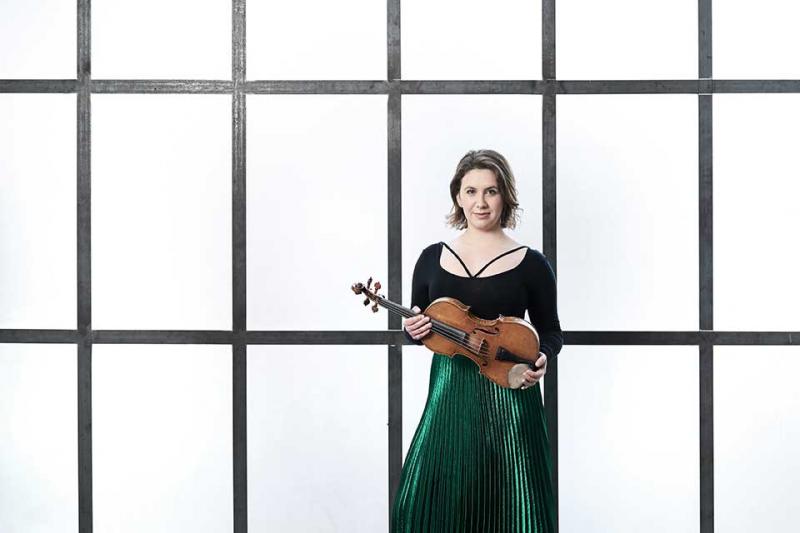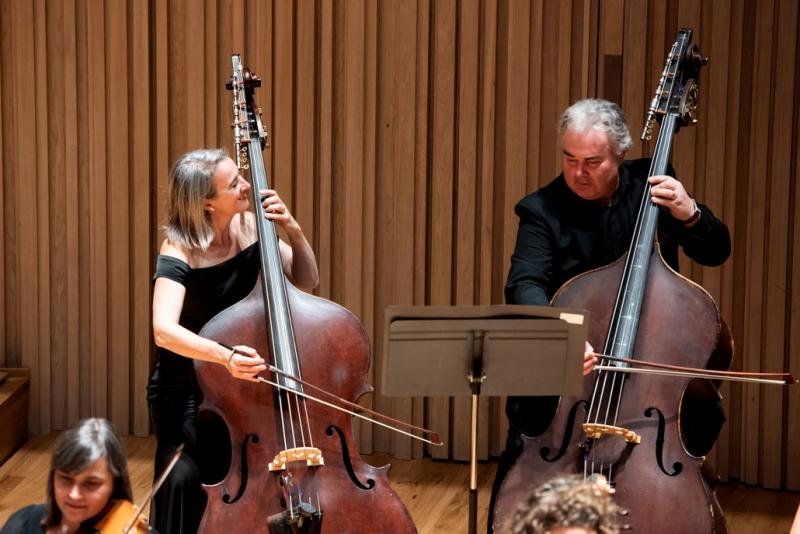Hanslip, Northern Chamber Orchestra, Stoller Hall, Manchester review - lyricism and challenge | reviews, news & interviews
Hanslip, Northern Chamber Orchestra, Stoller Hall, Manchester review - lyricism and challenge
Hanslip, Northern Chamber Orchestra, Stoller Hall, Manchester review - lyricism and challenge
Top violinist puts conductor-less orchestra through its paces

Manchester’s oldest chamber orchestra has been gathering a new audience at the Stoller Hall in Chetham’s School of Music since that auditorium opened, and Sunday afternoon’s programme provided an excellent example of where the Northern Chamber Orchestra’s virtues lie.
With Chloë Hanslip, the orchestra’s artist in association, appearing as both soloist and director, it also happened to have been selected by the BBC for recording for a radio focus on Manchester music-making, to come in January. (When you listen to that you may just detect some querulous cries and bumps arising from the presence of very young children in the hall in the first half of the concert …. The NCO does a great job in connecting with audiences of the future, too..
But if the first half of the performance was meant to be a demonstration of the most immediately appealing qualities of this small body of top-class string players, led by Nicholas Ward, it was a success. The strings are the heart of the NCO, and, being small in number, they play as real chamber musicians (usually without any conductor at all). The richness and vibrancy of the tone they can make from such small human resources was there from the first notes of Grieg’s Holberg Suite – perfectly incisive and a real coup de l’archet, followed immediately by the beauty of their dolce tone for the Praeludium’s delicious first tune.
Maybe the second violins weren’t quite so perfect on their own a few moments later, but that hardly mattered: the varied textures in the Gavotte movement were beautifully delivered, and in the Air (the least neo-baroque in flavour of all the movements of the suite) the cellos were heard at their best, and there were flashes of passion amid the elegance that made it seem almost like Elgar. Gerald Finzi’s string writing in his Romance is even more of a vehicle for gorgeous string playing than Grieg’s transcription of his own piano score, and here there was lovely warmth of a kind that seems inimitably English.  Real Elgar was to follow: the E minor Serenade for strings, played with poise and deep affection under Hanslip’s first-desk direction. The opening was taken quite briskly, but the middle movement grew in depth and beauty – and in it the second violins came into their own alongside the firsts, with noble sounds from violas and celli, also (pictured above by Sara Porter photography, double-bass players Diane Clark and James Manson).
Real Elgar was to follow: the E minor Serenade for strings, played with poise and deep affection under Hanslip’s first-desk direction. The opening was taken quite briskly, but the middle movement grew in depth and beauty – and in it the second violins came into their own alongside the firsts, with noble sounds from violas and celli, also (pictured above by Sara Porter photography, double-bass players Diane Clark and James Manson).
So far, so elegiac, lyrical and even easy on the ear. But the NCO is made of tougher stuff than this, and for the second part of the concert Hanslip was their soloist in Shostakovich’s Sonata for violin, percussion and string orchestra – an odd title for something that’s not far off being a full-blown concerto (written for David Oistrakh). The percussionist, the RNCM and Chetham’s Andrea Vogler on this occasion, is close to being a second star of the piece, as Shostakovich asks her to bring pretty well everything but the kitchen sink to the party: wood block, side drum, bass drum, cymbals, gong … Together the strings and that lot can build quite an amount of noise.
It's challenging, too – not simply to the soloist and other players, but to the listener, starting off with a 12-tone row and rarely indulging in sweetness (though it’s the more effective when it does). Hanslip and the orchestra created an ethereal opening and mysterious close to the Andante, with episodes of burlesque and vehemence in the music in between.
Furious fiddling, horsehair flying by the end, was apparent in the finely accomplished scherzo-style second movement, but the emotional weight of the work lay in its long, quasi-passacaglia-style finale. There were flashes of lyricism and longing, but the first rumbling, and then thunderous, tutti climax was a worthy high-point –followed by a sizzling cadenza, made for the Hanslip Guarneri to shine. It was a serious piece of serious music-making.
rating
Explore topics
Share this article
The future of Arts Journalism
You can stop theartsdesk.com closing!
We urgently need financing to survive. Our fundraising drive has thus far raised £49,000 but we need to reach £100,000 or we will be forced to close. Please contribute here: https://gofund.me/c3f6033d
And if you can forward this information to anyone who might assist, we’d be grateful.

Subscribe to theartsdesk.com
Thank you for continuing to read our work on theartsdesk.com. For unlimited access to every article in its entirety, including our archive of more than 15,000 pieces, we're asking for £5 per month or £40 per year. We feel it's a very good deal, and hope you do too.
To take a subscription now simply click here.
And if you're looking for that extra gift for a friend or family member, why not treat them to a theartsdesk.com gift subscription?
more Classical music
 BBC Proms: Ehnes, Sinfonia of London, Wilson review - aspects of love
Sensuous Ravel, and bittersweet Bernstein, on an amorous evening
BBC Proms: Ehnes, Sinfonia of London, Wilson review - aspects of love
Sensuous Ravel, and bittersweet Bernstein, on an amorous evening
 Presteigne Festival 2025 review - new music is centre stage in the Welsh Marches
Music by 30 living composers, with Eleanor Alberga topping the bill
Presteigne Festival 2025 review - new music is centre stage in the Welsh Marches
Music by 30 living composers, with Eleanor Alberga topping the bill
 Lammermuir Festival 2025 review - music with soul from the heart of East Lothian
Baroque splendour, and chamber-ensemble drama, amid history-haunted lands
Lammermuir Festival 2025 review - music with soul from the heart of East Lothian
Baroque splendour, and chamber-ensemble drama, amid history-haunted lands
 BBC Proms: Steinbacher, RPO, Petrenko / Sternath, BBCSO, Oramo review - double-bill mixed bag
Young pianist shines in Grieg but Bliss’s portentous cantata disappoints
BBC Proms: Steinbacher, RPO, Petrenko / Sternath, BBCSO, Oramo review - double-bill mixed bag
Young pianist shines in Grieg but Bliss’s portentous cantata disappoints
 theartsdesk at the Lahti Sibelius Festival - early epics by the Finnish master in context
Finnish heroes meet their Austro-German counterparts in breathtaking interpretations
theartsdesk at the Lahti Sibelius Festival - early epics by the Finnish master in context
Finnish heroes meet their Austro-German counterparts in breathtaking interpretations
 Classical CDs: Sleigh rides, pancakes and cigars
Two big boxes, plus new music for brass and a pair of clarinet concertos
Classical CDs: Sleigh rides, pancakes and cigars
Two big boxes, plus new music for brass and a pair of clarinet concertos
 Waley-Cohen, Manchester Camerata, Pether, Whitworth Art Gallery, Manchester review - premiere of no ordinary violin concerto
Images of maternal care inspired by Hepworth and played in a gallery setting
Waley-Cohen, Manchester Camerata, Pether, Whitworth Art Gallery, Manchester review - premiere of no ordinary violin concerto
Images of maternal care inspired by Hepworth and played in a gallery setting
 BBC Proms: Barruk, Norwegian Chamber Orchestra, Kuusisto review - vague incantations, precise laments
First-half mix of Sámi songs and string things falters, but Shostakovich scours the soul
BBC Proms: Barruk, Norwegian Chamber Orchestra, Kuusisto review - vague incantations, precise laments
First-half mix of Sámi songs and string things falters, but Shostakovich scours the soul
 BBC Proms: Alexander’s Feast, Irish Baroque Orchestra, Whelan review - rapturous Handel fills the space
Pure joy, with a touch of introspection, from a great ensemble and three superb soloists
BBC Proms: Alexander’s Feast, Irish Baroque Orchestra, Whelan review - rapturous Handel fills the space
Pure joy, with a touch of introspection, from a great ensemble and three superb soloists
 BBC Proms: Moore, LSO, Bancroft review - the freshness of morning wind and brass
English concert band music...and an outlier
BBC Proms: Moore, LSO, Bancroft review - the freshness of morning wind and brass
English concert band music...and an outlier
 Willis-Sørensen, Ukrainian Freedom Orchestra, Wilson, Cadogan Hall review - romantic resilience
Passion, and polish, from Kyiv's musical warriors
Willis-Sørensen, Ukrainian Freedom Orchestra, Wilson, Cadogan Hall review - romantic resilience
Passion, and polish, from Kyiv's musical warriors
 BBC Proms: Faust, Gewandhausorchester Leipzig, Nelsons review - grace, then grandeur
A great fiddler lightens a dense orchestral palette
BBC Proms: Faust, Gewandhausorchester Leipzig, Nelsons review - grace, then grandeur
A great fiddler lightens a dense orchestral palette

Add comment